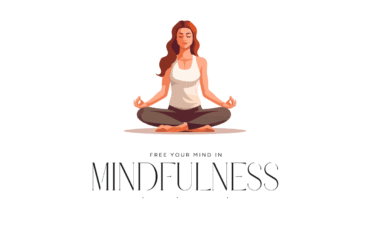You’re standing in line, checking your phone. Your mind is racing with deadlines, worries, what-ifs and to-do lists.
You snap back and realize that you’ve been lost in thought for the last 15 minutes.
Sound familiar?
In today’s busy world, we live more in our heads than in the present. But what if you could break that pattern anytime, anywhere and in just a few moments?
Mindfulness makes this possible.
You don’t need a yoga mat, a meditation cushion, or hours of free time. Mindfulness can fit into your daily life even in the middle of a stressful workday or grocery run.
In this article, you’ll discover 5 simple mindfulness exercises that you can do at your desk, on the bus, in line at the grocery store or wherever you are. We’ll break down the research, offer step-by-step guidance, and explain exactly how each practice benefits your brain and body.
Whether you’re a busy professional, a student, a parent, or anyone craving calm and clarity, these exercises are for you.
What Is Mindfulness? (And Why Does It Work?)
Mindfulness is the practice of bringing your full attention to the present moment, with openness, curiosity, and without judgment. Instead of being lost in thought about the past or future, mindfulness invites you to experience what’s happening right now in your mind, body, and environment.
This isn’t just a “feel good” fad. Over the past two decades, neuroscientists and psychologists have confirmed that mindfulness changes the brain, reduces stress hormones, and improves emotional resilience.
Major benefits of mindfulness include:
- Lower stress and anxiety levels
- Enhanced focus and concentration
- Improved emotional regulation and resilience
- Better sleep and physical health
- Increased happiness and self-compassion
The best part? Mindfulness is accessible to everyone regardless of age, religion, or lifestyle. And you can practice it anywhere.
5 Simple Mindfulness Exercises You Can Do Anywhere (Backed by Science)
Let’s dive into the top five practices you can easily integrate into your daily life.
- Mindful Breathing: The Anchor for Calm
- Sit or stand comfortably, feet flat on the floor, hands resting naturally.
- Close your eyes or soften your gaze.
- Bring your attention to your breath, notice the sensation of air entering and leaving your nose, the rise and fall of your chest or belly.
- If your mind wanders (and it will!), gently notice it, and return your focus to your breath.
- Continue for 1-5 minutes (or longer if you like).
- Waiting for a meeting to start
- During a stressful commute
- Before sleep
- Anytime you feel overwhelmed
- The Body Scan: A Tune-Up for Mind and Body
Bring awareness to different parts of your body, one at a time, noticing sensations without judgment.
Why it works:
Many of us live “in our heads,” disconnected from bodily sensations. The body scan grounds you in the present and helps release tension, reduce pain, and promote relaxation.
The Science:
A study by Hölzel et al. (2011) in Psychiatry Research showed that participants who practiced body scan meditation for eight weeks had reduced cortisol (stress hormone) levels and improved emotional regulation . Body scans are a core component of Mindfulness-Based Stress Reduction (MBSR), a gold-standard clinical program for anxiety, depression, and chronic pain . - Find a comfortable position, sitting or lying down.
- Close your eyes.
- Start at your toes. Notice any sensations (warmth, tingling, tightness) without trying to change them.
- Slowly move your attention up feet, legs, hips, abdomen, chest, back, hands, arms, neck, face.
- If you notice tension, see if you can simply allow it to be there, or imagine it softening with each breath.
- If your mind drifts, gently bring it back to the body part you’re focusing on.
- During a lunch break
- Lying in bed to help fall asleep
- Whenever you notice tension or pain
- Five Senses Grounding: Reconnect Instantly with the Present
Use your five senses to anchor yourself in the “now,” especially helpful for anxiety and overwhelm.
Why it works:
When stress or worry hijacks your mind, the five senses exercise instantly grounds you in reality. By focusing on what you can see, hear, feel, smell, and taste, you break the loop of anxious thoughts.
The Science:
Psychologists use this “grounding” technique in evidence-based therapies such as Dialectical Behavior Therapy (DBT) and Trauma-Informed Mindfulness.
Research shows that engaging in multiple senses helps shift attention from distressing thoughts to the present, lowering physiological arousal .
How to do it (The “5-4-3-2-1” Method):
5: Look around and name five things you can see
(e.g., a tree, your shoes, a pattern on the wall).
4: Notice four things you can feel
(e.g., the chair under you, your feet on the ground, air on your skin, your pulse).
3: Listen and name three things you can hear
(e.g., birds chirping, your own breath, distant voices).
2: Identify two things you can smell
(or recall favorite scents if none are obvious).
1: Focus on one thing you can taste
(a sip of water, gum, or just notice the taste in your mouth).
When to use it:
- During a lunch break
- Lying in bed to help fall asleep
- Whenever you notice tension or pain
- Mindful Walking: Meditation in Motion
Turn an everyday activity like walking into a moving meditation by focusing on each step and sensation.
Why it works:
Walking is something most of us do daily yet rarely pay attention to. By bringing mindfulness to walking, you can find calm and clarity even on your busiest days.
The Science:
A 2016 study in Mindfulness journal found that mindful walking reduced anxiety, improved mood, and increased present-moment awareness in university students compared to regular walking . Other research links mindful walking to lower blood pressure, improved sleep, and greater resilience .
How to do it:
a. Stand still for a moment, feel your feet on the ground.
b. Start walking slowly. Notice the sensations in your feet and legs with each step.
c. Pay attention to the rhythm lifting, moving, and placing each foot.
d. Notice the movement of your arms, the feeling of air, the sounds and sights around you.
e. If your mind wanders, gently bring it back to the sensation of walking.
When to use it: - During a lunch break
- Lying in bed to help fall asleep
- Whenever you notice tension or pain
- Loving-Kindness Meditation: Boosting Self-Compassion Anywhere
Send kind wishes to yourself and others, cultivating warmth and emotional resilience.
Why it works:
Anxiety and stress are often fueled by self-criticism and harsh inner dialogue. Loving-kindness meditation (also called “metta”) shifts your mindset to one of care, connection, and compassion.
The Science:
Neuroscientific studies show that loving-kindness meditation activates brain regions linked to empathy and positive emotions (like the insula and anterior cingulate cortex) .
A meta-analysis in Psychological Bulletin found that loving-kindness practices reduce symptoms of depression and anxiety and increase self-acceptance and social connection .
How to do it:
i. Sit comfortably and close your eyes.
ii. Take a few deep breaths.
iii. Silently repeat phrases such as:
– May I be safe.
– May I be happy.
– May I be healthy.
– May I live with ease.
iv. After a few minutes, extend these wishes to someone you care about
(“May you be safe…”) and then, if you feel comfortable, to others even people you have difficulty with.
v. Focus on generating a sense of warmth and kindness.
When to use it: - Anytime you notice negative self-talk
- When feeling lonely or disconnected
- As a daily practice to boost mood and resilience
Focus your attention on the natural flow of your breath, bringing your mind back whenever it wanders.
Why it works:
Breathing is always available, no matter where you are. When you pay mindful attention to your breath, you engage the body’s relaxation response, lowering heart rate and calming the mind.
The Science:
A 2018 meta-analysis published in “Frontiers in Psychology” found that even short bouts of mindful breathing (as little as 5-10 minutes) significantly reduce anxiety and promote relaxation . MRI studies show that mindful breathing activates the prefrontal cortex, the brain’s center for emotional regulation and reduces amygdala (fear center) activity .
How to do it:
When to use it:
Pro Tip:
Try the “4-7-8” breath: Inhale for 4 seconds, hold for 7, exhale for 8. This technique is clinically shown to lower anxiety and prepare the body for rest .
How to do it:
When to use it:
Pro Tip:You can do a “mini” body scan in 1-2 minutes by sweeping your attention from head to toe quickly ideal when you’re on the go.
Pro Tip:
Practice this in nature for a powerful mood boost. Studies show that combining mindfulness with time outdoors significantly reduces stress and improves mood.
Pro Tip:
Practice this in nature for a powerful mood boost. Studies show that combining mindfulness with time outdoors significantly reduces stress and improves mood.
Pro Tip:
Practice this in nature for a powerful mood boost. Studies show that combining mindfulness with time outdoors significantly reduces stress and improves mood.

The Science Behind Mindfulness: How Just a Few Minutes a Day Makes a Difference
Is there really evidence that these brief, everyday practices “work”? Yes! Let’s highlight the key findings:
- Mindfulness Changes Your Brain
-
- Structural MRI studies show increased gray matter density in areas related to learning, memory, emotion regulation, and perspective-taking after regular mindfulness practice even as little as 10-15 minutes a day for several weeks .
- Mindfulness decreases activity in the amygdala (fear and stress center) and increases activity in the prefrontal cortex (planning and regulation center) .
-
- Mindfulness Reduces Stress Hormones
-
- Regular mindfulness practice lowers cortisol, the main stress hormone, reducing physical symptoms of anxiety and improving overall health.
-
- Mindfulness Boosts Focus and Cognitive Performance
-
- Studies at Harvard and the University of California found improved attention, memory, and executive function after brief daily mindfulness training .
-
- Mindfulness Builds Emotional Resilience
-
- Mindfulness cultivates self-awareness and emotional acceptance, making it easier to cope with difficult thoughts and feelings.
- Loving-kindness meditation increases self-compassion and reduces self-criticism, which is crucial for mental health.
-
Practical Tips: How to Make Mindfulness a Habit Anywhere
- Start small: Even one minute of mindful breathing or grounding can make a difference.
- Link it to daily activities: Practice mindful walking on your way to the bathroom, or do a body scan as you fall asleep.
- Use reminders: Set an alarm, sticky note, or phone notification as a gentle nudge.
- Be patient: Your mind will wander, that’s normal! Every time you notice and return your focus, you’re building your “mindfulness muscle.”
- Mix it up: Try different exercises to see which resonates with you, or rotate them based on your mood and situation.
Frequently Asked Questions
How long before I see results?
Research shows that even one session can reduce anxiety and boost mood, but lasting benefits (like brain changes and lower stress hormones) typically appear after 2-8 weeks of regular practice.
Can I do these practices in public?
Absolutely! Most exercises can be done discreetly mindful breathing, body scan, five senses, and loving-kindness can all be practiced without anyone noticing.
Do I need any special equipment?
No, mindfulness is portable, free, and always available.
What if I “fail” or my mind won’t settle?
There’s no failure in mindfulness. If your mind wanders 100 times and you bring it back 101, that’s success!
Small Moments, Big Results
Mindfulness doesn’t require silence, solitude, or special skills. The real magic lies in returning, again and again, to this moment whether you’re at your desk, on a walk, or stuck in traffic. Science confirms that simple, portable mindfulness exercises lower stress, boost resilience, and help you meet daily challenges with clarity and calm.
Try these five exercises today, and notice how small moments of mindfulness can lead to big changes in your well-being.
Remember: Every breath, every step, every sense can be an opportunity to come home to yourself right here, right now.





